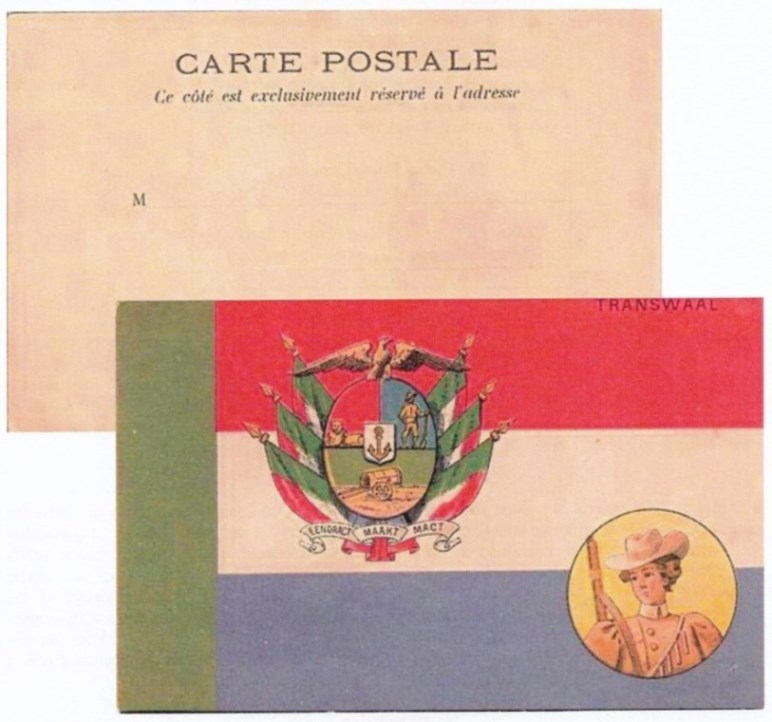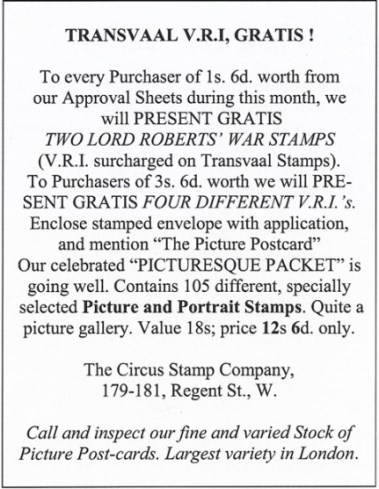
Figure 1. From the author’s collection; a colour printed postcard captioned “TRANSWAAL” at upper right.
The undivided address side is printed black and the publisher is not credited.
Jeff Woolgar
This article was first published in The Transvaal Philatelist, 20121
Introduction
The editorial in the first edition of The Picture Postcard, A Magazine of Philately, Travel, & Art, contains the phrase “What! another magazine?” This new magazine published in England during July 1900, was well illustrated with picture postcards, which were mainly published and printed in mainland Europe.1a Headed “Kruger Cards” page ten of the January 1901 edition, illustrates a picture postcard, of which the editor comments “A Lady Boer, who has presumably fought for her country ...”. 2 In addition, the postcard has the words “SOUTH AFRICA” reversed out in white at bottom left, a feature which does not appear on the postcard illustrated below, or on others seen by the writer and it was almost certainly placed there on the instructions of the editor, Mr. E.W. Richardson.

Figure 1. From the author’s collection; a colour printed postcard captioned “TRANSWAAL” at upper right.
The undivided address side is printed black and the publisher is not credited.
When describing pro-Boer postcards, the Editor mocks the ZAR and writes: “[These] are pictorial post-cards which Britain could well do without, and which even the most enthusiastic collectors could dispense with. No new censorship is needed; there are powers in existence that could deal with the case, and it is surprising that cards that ought not to be allowed are openly shown in shop windows. All the ‘undesirables’ are made in France.”. Similar comments appeared in later editions, but Richardson continued to illustrate such picture postcards!
Lord Roberts’ War Stamps
Patriotism was also to be found in the advertisements of the day. The following is an advertisement placed in this magazine by a stamp and postcard dealer.3

Figure 2. This advertisement was first printed in volume 1, No.1, of July, 1900 of
The Picture Postcard, A Magazine of Philately, Travel, & Art.
Postcard collectors
When referring to a postcard fair, the editor writes “Women are far keener collectors than men. This was attributed by the secretary of the exhibition to the fact that the fair sex get their cards for nothing from absent admirers ... men collectors prefer views of interesting places all over the world and purchase no others ...”. 4 There was an advertisement for “The Ladies’ International picture Post-card exchange society” which was based in Sheffield although, not surprisingly, it appears not to have been repeated.
Later editions
The title of the magazine was soon altered; 5 a critic would surely have drawn attention to the fact that the magazine contained neither “travel” nor “art”. The new title from July 1902 was The Picture Postcard, and Collectors’ Chronicle. Here at least, some articles were published on such items as photography and methods, whereby readers could produce, their own picture postcards. The editor also visited commercial postcard producers and included high-quality illustrations of the machinery, bench hands and printing works. However, the reader would have gained little knowledge of the manufacture of picture postcards with tongue-in-cheek statements such as “You put the paper in at one end, and the post-card comes out at the other”.6
Conclusion
Although magazines such as this, published over a hundred years ago, may be thought of little consequence today, they can be useful in ascertaining, as near as possible, the dates these postcards were first published. There were often reprints of so called ‘Boer War’ picture postcards, with one such advertisement in this magazine as early as October, 1901.
Unfortunately, some magazines still add figure numbers, descriptions, etc. over illustrations of postcards. At least Richardson soon abandoned this practice; he reproduced clear black and white illustrations on good quality paper, and mentions the retail price of picture postcards in London. However, like so many magazines today, he only concentrated on the picture side. When describing picture postcards both the picture and address sides need to be explained, together with details of the colour, caption and publisher if the whole story is to be understood and reprints discovered.
All too often, authors writing in philatelic magazines today, about picture postcards, from the early twentieth century, do not appear to understand the polity or organised propaganda of the period. They often assume that the descriptions and spelling of captions are correct, and that pro-Boer picture postcards were published as part of some great prearranged propaganda scheme, which is generally not the case. Most publishers and printers produced these cards in order to make a profit. In the same vein Richardson produced the type of magazine that would sell; jingoistic it may have been, but doubtless that was what his readers wanted.
References and Notes
1 Woolgar, J., (2013), ‘Picture Postcard, A Magazine of Philately, Travel, & Art: A Review’, The Transvaal Philatelist, (184), pp.15-17.
1a Richardson E.W., (Editor), The Picture Postcard, A Magazine of Philately Travel, & Art, Vol. 1, No.1, July, 1900 [The British Library Shelfmark: Crawford 2106. This is also available on microfilm Shelfmark: Mic 19590].
2 ibid, Vol. II, No.7, January 1901, p.10.
3 ibid, Vol. II, No.7, January 1901, p.15. This advertisement appeared in all subsequent issues until September, 1901.
4 ibid, Vol. II, No.9, March 1901, p.48.
5 The Picture Postcard, and Collectors’ Chronicle.
[The British Library, Crawford Library holds editions to 1907 The Shelfmark is the same as that given above in reference 1a, there are six bindings in all.] 6 ibid, Vol. VII, No.70, April 1906, p.110.
- - 'Back to Postcards. - -
Copyright © Jeff Woolgar 2013 and 2020
- - o - -